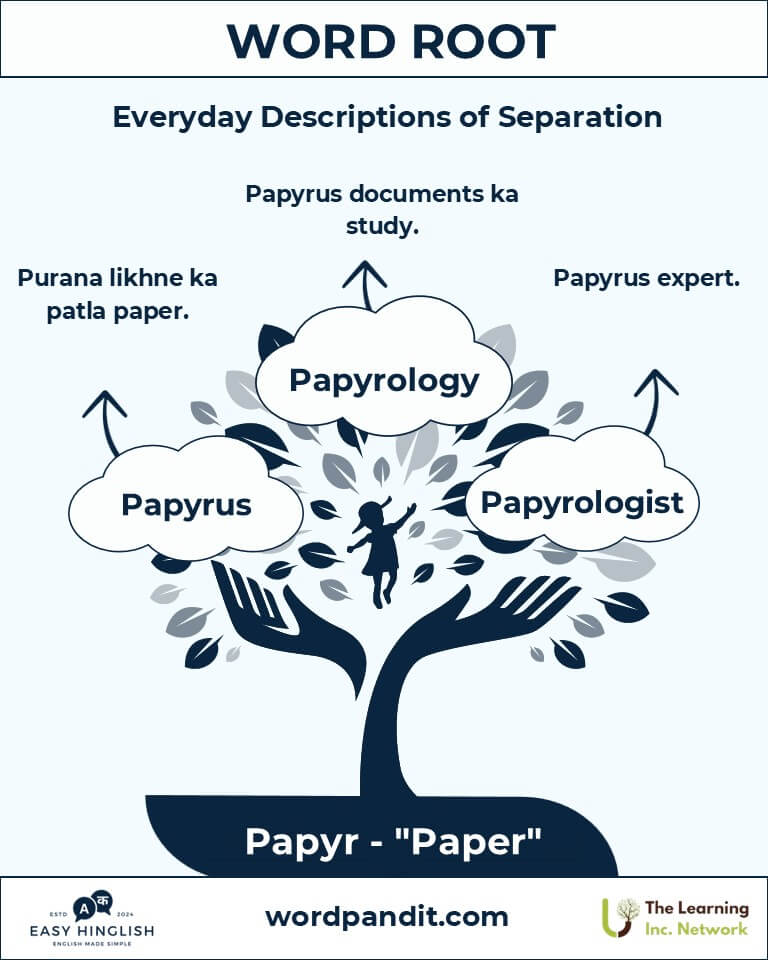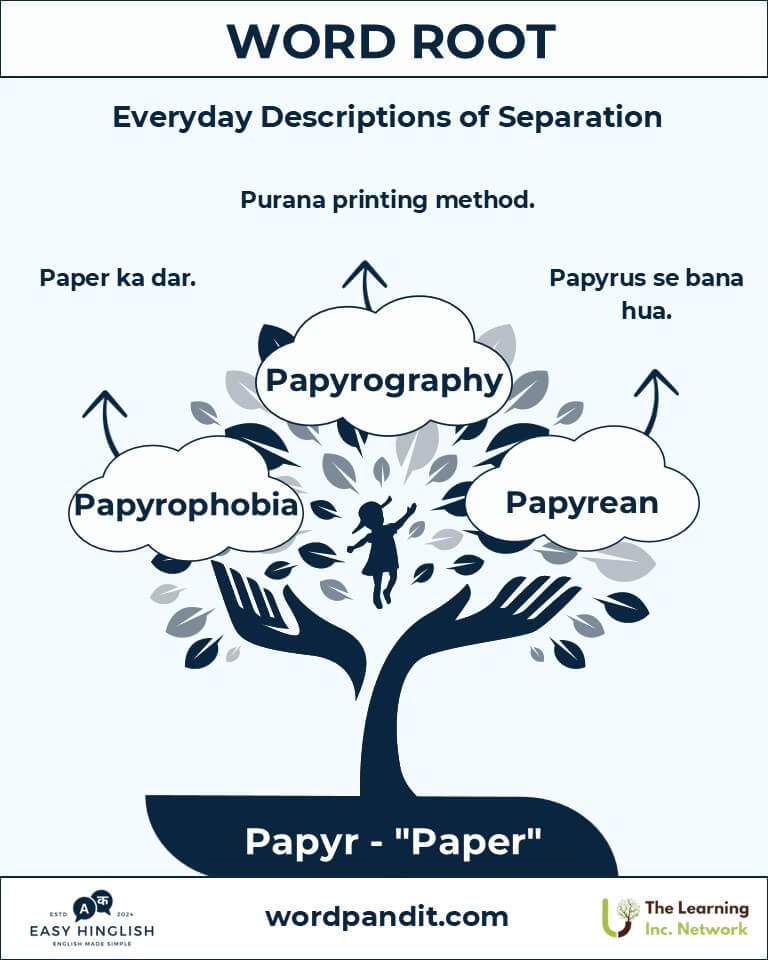Papyr: Unrolling the Ancient Roots of Paper and Writing
(Papyr: Kagaz aur Lekhan ki Prachin Jad - पेपर और लेखन की प्राचीन जड़)
Discover the fascinating legacy of the root "papyr," meaning "paper." From its origins in ancient Egypt to its role in modern terminology, "papyr" has shaped the way humanity records, preserves, and communicates knowledge.

Table of Contents
- Introduction: The Essence of Papyr
- Etymology and Historical Journey
- Mnemonic: Unlocking the Power of Papyr
- Common Papyr-Related Terms
- Papyr Through Time
- Papyr in Specialized Fields
- Illustrative Story: Papyr in Action
- Cultural Significance of the Papyr Root
- The Papyr Family Tree
- FAQs About the Papyr Word Root
- Test Your Knowledge: Papyr Mastery Quiz
- Conclusion: The Living Legacy of Papyr
Introduction: The Essence of Papyr
(Papyr ka Mool Arth - Papyr का मूल अर्थ)
Imagine holding a piece of papyrus, the material that sparked a revolution in writing and knowledge-sharing. The word root "papyr" (pronounced "pa-peer") originates from ancient Egyptian culture, where papyrus, a plant-based material, served as the first "paper." Today, the root symbolizes writing, documentation, and even lightweight structures in botany.
Etymology and Historical Journey
(Papyr ki Utpatti aur Itihas - Papyr की उत्पत्ति और इतिहास)
- Root Origin: The root "papyr" derives from the Greek word "papyros," which itself originated from Egyptian "papuro," referring to the papyrus plant.
- Ancient Usage: Papyrus was vital in ancient civilizations, providing a portable medium for record-keeping, literature, and art.
- Modern Evolution: Over centuries, "papyr" evolved into the modern "paper," maintaining its connection to recording human history.
Mnemonic: Unlocking the Power of Papyr
(Mnemonic ke Zariye Papyr ko Yaad Rakhein - Mnemonic के ज़रिए Papyr को याद रखें)
To remember "papyr," picture an ancient Egyptian scribe crafting a scroll of papyrus under a golden sun.
Mnemonic Device: “Papyr preserves stories on scrolls, from the past to the present.”
Common Papyr-Related Terms
(Papyr se Jude Common Words - Papyr से जुड़े सामान्य शब्द)
- Papyrus (पपीरस): A writing material made from the papyrus plant.
Example: "The archaeologists discovered an ancient papyrus scroll in the ruins." - Papyraceous (पपीरेशस): Thin and paper-like in texture.
Example: "The tree's papyraceous leaves rustled delicately in the wind." - Papyriform (पपीरीफॉर्म): Shaped like or resembling papyrus.
Example: "The decorative vase had a papyriform base, inspired by Egyptian design."
Papyr Through Time
(Samay ke Saath Papyr ka Safar - समय के साथ Papyr का सफर)
- Ancient Egypt: Papyrus was extensively used for scrolls, hieroglyphic texts, and illustrations.
- Medieval Era: Paper production techniques replaced papyrus, but its legacy persisted in the art of bookmaking.
- Modern Botany: The term "papyraceous" emerged to describe leaves or plants with paper-thin qualities.
Papyr in Specialized Fields
(Vishesh Kshetron mein Papyr ka Upyog - विशेष क्षेत्रों में Papyr का उपयोग)
- History & Archaeology: Papyrus scrolls are crucial in studying ancient civilizations, particularly Egyptian, Greek, and Roman cultures.
- Botany: Papyraceous plants are identified by their thin, paper-like textures.
- Art & Calligraphy: Traditional paper-making and calligraphy still draw inspiration from the ancient methods of papyrus production.
Illustrative Story: Papyr in Action
(Papyr ki Ek Kahani - Papyr की एक कहानी)
Amira, an Egyptologist, spent years studying a newly discovered tomb. Within the chamber, she uncovered a fragile papyrus manuscript detailing the medical knowledge of ancient healers. Carefully restoring and translating it, she brought forgotten remedies into modern research. This discovery reaffirmed how "papyr" connects the past with the present.
Cultural Significance of the Papyr Root
(Papyr Root ka Sanskritik Mahatva - Papyr रूट का सांस्कृतिक महत्व)
From sacred texts to poetry, papyrus symbolized wisdom and civilization. Even today, libraries and archives carry the spirit of "papyr" in their role as preservers of human thought and knowledge.
The Papyr Family Tree
(Papyr Root se Jude Shabdon ka Parivar - Papyr रूट से जुड़े शब्दों का परिवार)
- Script- (लिखना):
- Manuscript: Handwritten text.
- Scriptorium: A place where texts are copied.
- Graph- (चित्रण):
- Typography: The art of arranging text.
- Calligraphy: Artistic handwriting.

FAQs About the Papyr Word Root
Q: "Papyr" ka kya matlab hai?
A: "Papyr" ka matlab hai "paper" ya "writing material." Yeh root Greek word "papyros" se aaya hai, jo ancient Egyptian "papuro" se nikla hai, jisme papyrus plant ka use likhne ke liye hota tha.
Q: "Papyrus" ka itihas kya hai?
A: "Papyrus" ek prachin Egyptian material tha jo likhne ke liye istemal hota tha. Yeh ek plant-based paper tha jo scrolls aur documents likhne ke liye use kiya jata tha.
Q: "Papyraceous" ka kya arth hai?
A: "Papyraceous" ek adjective hai jo kisi cheez ki patli, paper jaisi texture ko describe karta hai. Yeh term botany mein patle aur fragile patton ya tissues ke liye use hota hai.
Q: Papyrus aur modern paper mein kya difference hai?
A: Papyrus ek natural plant-based sheet hoti thi jo layering aur pressing se banti thi, jabki modern paper wood pulp aur chemical processes ka upyog karke banta hai.
Test Your Knowledge: Papyr Mastery Quiz
1. "Papyr" root ka kya arth hai?
2. "Papyrus" kis civilization mein sabse pehle use kiya gaya tha?
3. "Papyraceous" kis quality ko describe karta hai?
4. Papyrus aur modern paper ke beech ka main difference kya hai?
5. Kis term ka arth "papyrus jaisa dikhne waala" hai?
Conclusion: The Living Legacy of Papyr
(Papyr ki Jeevant Virasat - Papyr की जीवंत विरासत)
"Papyr" humein likhit shabdon ki shakti aur gyaan ko surakshit karne ki importance dikhata hai. Yeh root sirf prachin samay tak seemit nahi hai, balki aaj bhi humein inspire karta hai ki hum knowledge ko kaise preserve karein.







